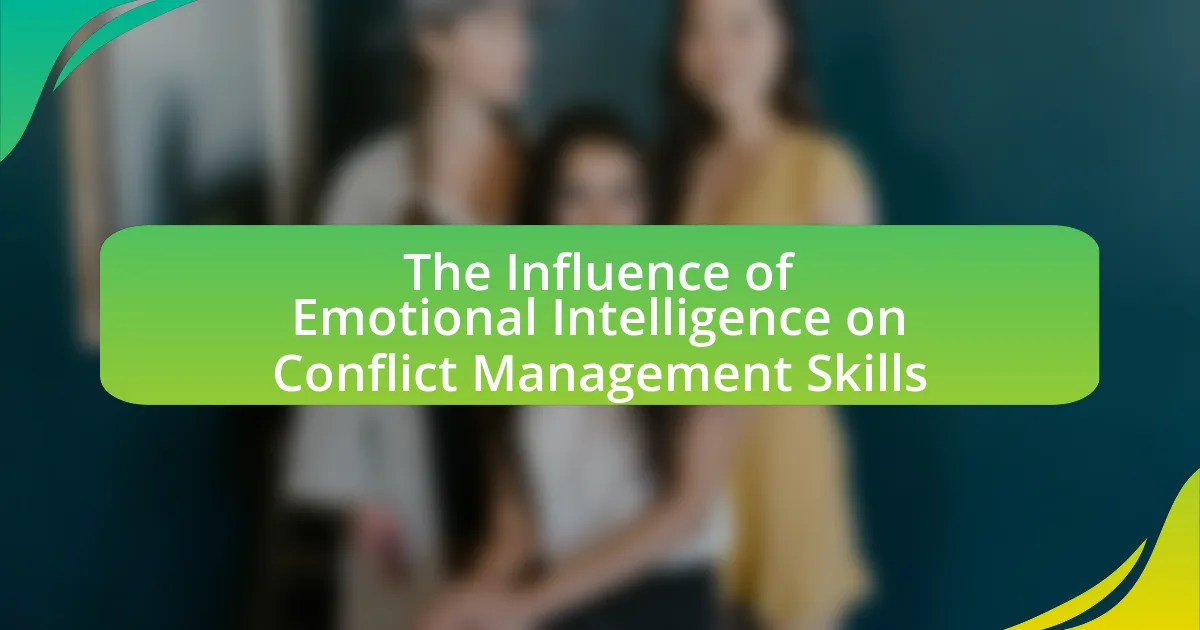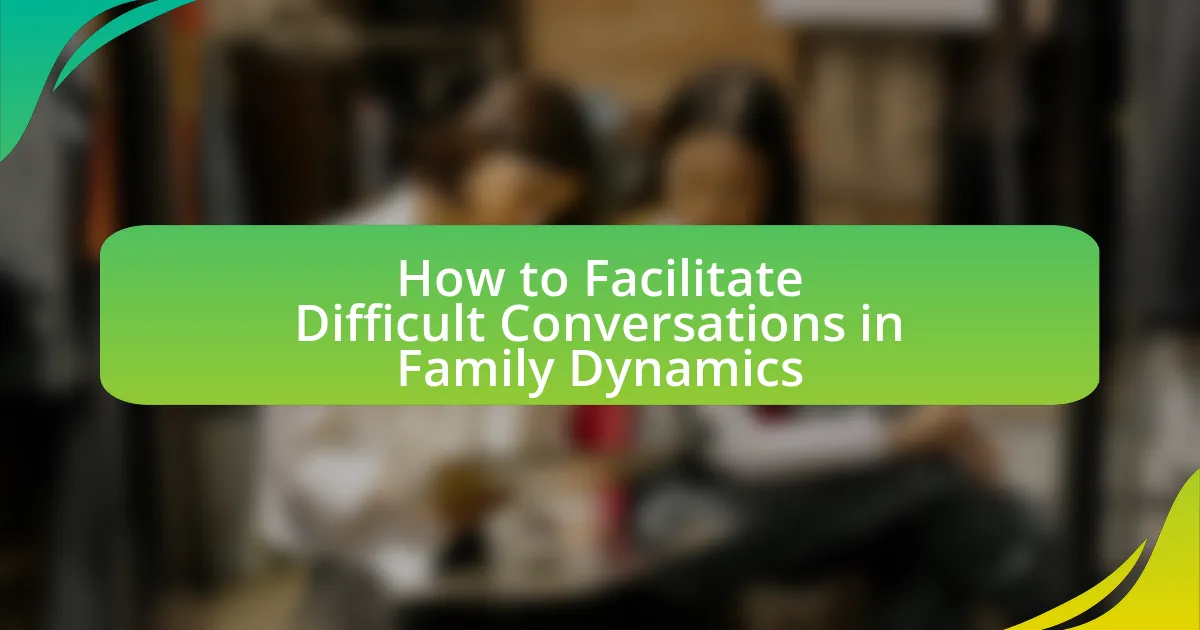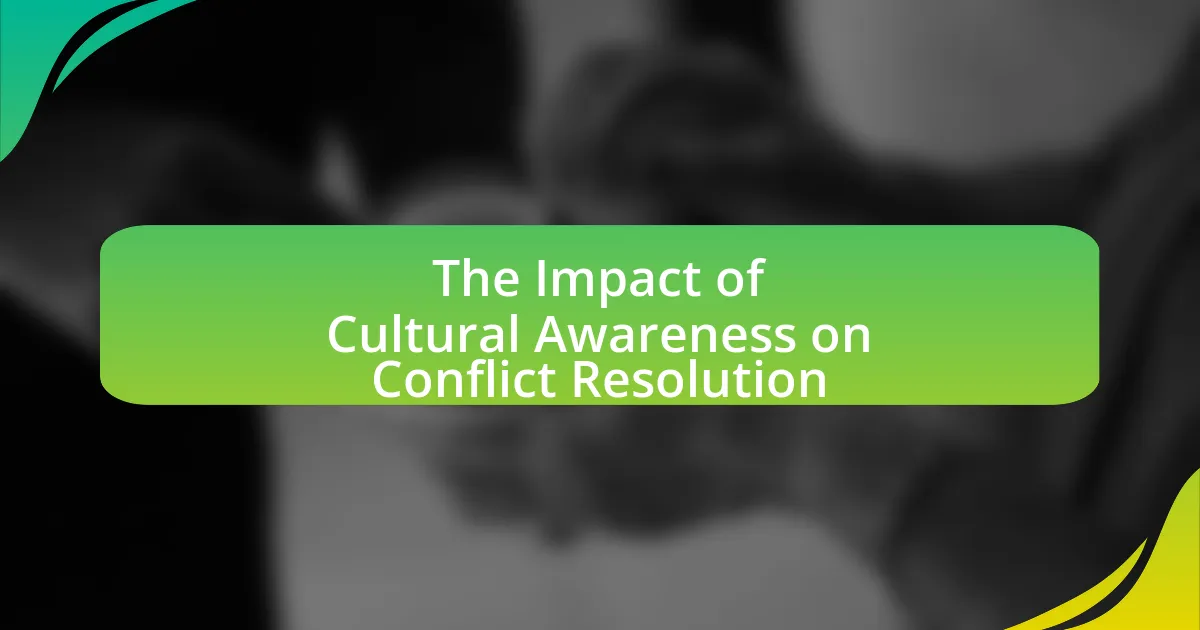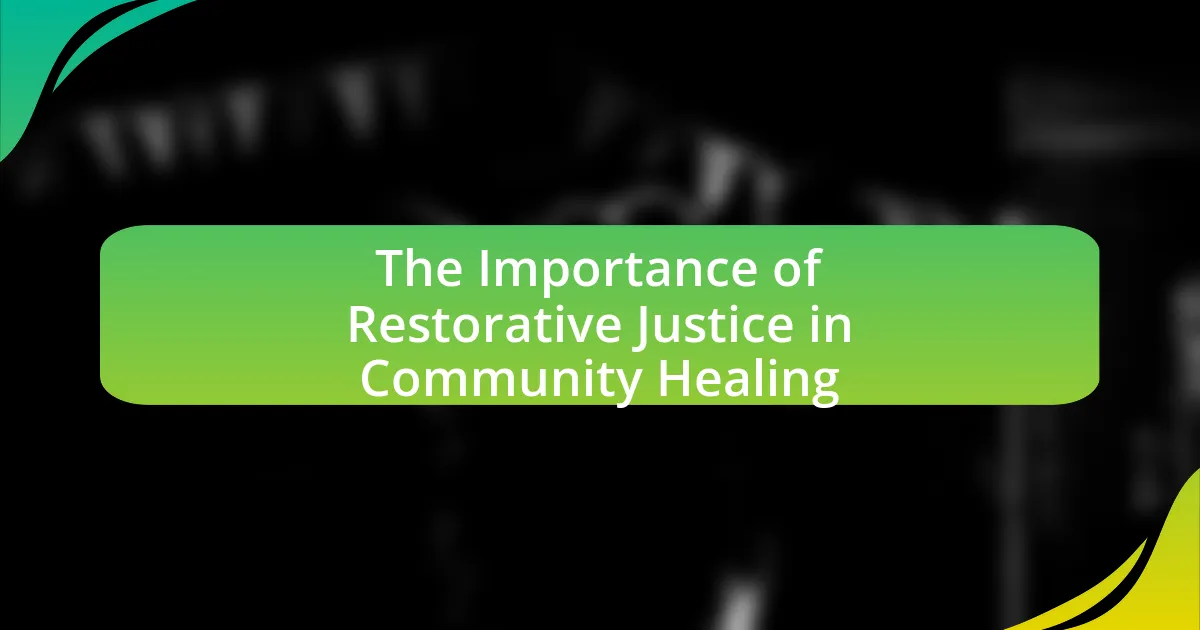Active listening is a vital communication technique that significantly enhances conflict resolution by promoting understanding and empathy among conflicting parties. This article explores the role of active listening in resolving disputes, highlighting its key principles, techniques, and the differences between active and passive listening. It discusses how active listening contributes to effective communication, reduces misunderstandings, and fosters a collaborative atmosphere, ultimately leading to more constructive outcomes in various conflict scenarios, including workplace and personal relationships. Additionally, the article addresses barriers to active listening and offers best practices for individuals to develop their skills over time.

What is the Role of Active Listening in Conflict Resolution?
Active listening plays a crucial role in conflict resolution by fostering understanding and empathy between conflicting parties. This communication technique involves fully concentrating, understanding, responding, and remembering what is being said, which helps to clarify issues and reduce misunderstandings. Research indicates that active listening can lead to more effective problem-solving and collaboration, as it encourages individuals to express their thoughts and feelings openly, thereby creating a safe environment for dialogue. For instance, a study published in the Journal of Conflict Resolution found that active listening significantly improved negotiation outcomes by enhancing trust and rapport among participants.
How does active listening contribute to resolving conflicts?
Active listening significantly contributes to resolving conflicts by fostering understanding and empathy between parties. When individuals engage in active listening, they demonstrate genuine interest in the other person’s perspective, which helps to clarify misunderstandings and reduce emotional tension. Research indicates that effective communication, characterized by active listening, can lead to a 70% increase in conflict resolution success rates, as it encourages open dialogue and collaborative problem-solving. By validating feelings and acknowledging concerns, active listening creates a safe environment for discussion, ultimately facilitating a more constructive resolution to conflicts.
What are the key principles of active listening?
The key principles of active listening include paying full attention, demonstrating understanding, providing feedback, and withholding judgment. Paying full attention involves focusing completely on the speaker, which enhances comprehension and shows respect. Demonstrating understanding can be achieved through verbal affirmations and non-verbal cues, indicating that the listener is engaged. Providing feedback, such as paraphrasing or summarizing what the speaker has said, confirms that the listener has accurately interpreted the message. Withholding judgment means refraining from forming opinions or responses until the speaker has finished, allowing for a more open and honest dialogue. These principles are essential in conflict resolution as they foster effective communication and mutual respect, leading to more constructive outcomes.
How does active listening differ from passive listening?
Active listening differs from passive listening in that active listening involves fully engaging with the speaker, demonstrating understanding and empathy, while passive listening entails merely hearing the words without active participation or feedback. Active listeners provide verbal and non-verbal cues, such as nodding or summarizing, to show they are processing the information, which enhances communication and conflict resolution. In contrast, passive listeners may miss key points and fail to respond appropriately, leading to misunderstandings. Research indicates that effective communication, characterized by active listening, can significantly reduce conflict and improve relationships, as highlighted in studies on interpersonal communication dynamics.
Why is active listening important in conflict situations?
Active listening is crucial in conflict situations because it fosters understanding and reduces tension. By actively engaging with the speaker, individuals can clarify misunderstandings and demonstrate empathy, which can de-escalate conflicts. Research indicates that effective communication, including active listening, can lead to more constructive outcomes in disputes, as it encourages collaboration rather than confrontation. For instance, a study published in the Journal of Conflict Resolution found that parties who practiced active listening were more likely to reach mutually beneficial agreements, highlighting its effectiveness in resolving conflicts.
What impact does active listening have on communication during conflicts?
Active listening significantly enhances communication during conflicts by fostering understanding and reducing misunderstandings. When individuals engage in active listening, they demonstrate attentiveness and empathy, which can de-escalate tensions and promote a collaborative atmosphere. Research indicates that active listening leads to improved conflict resolution outcomes, as it encourages parties to express their perspectives fully and feel heard. For instance, a study published in the Journal of Conflict Resolution found that active listening techniques, such as paraphrasing and summarizing, increased mutual respect and facilitated more constructive dialogue among conflicting parties.
How does active listening help in understanding different perspectives?
Active listening enhances understanding of different perspectives by fostering empathy and clarity in communication. When individuals engage in active listening, they focus entirely on the speaker, which allows them to grasp the nuances of the speaker’s viewpoint. This practice encourages the listener to ask clarifying questions and reflect back what they have heard, ensuring that they accurately interpret the speaker’s message. Research indicates that active listening can lead to improved interpersonal relationships and conflict resolution, as it reduces misunderstandings and promotes a collaborative atmosphere. For instance, a study published in the Journal of Conflict Resolution found that active listening significantly decreased conflict escalation and increased mutual understanding among participants.
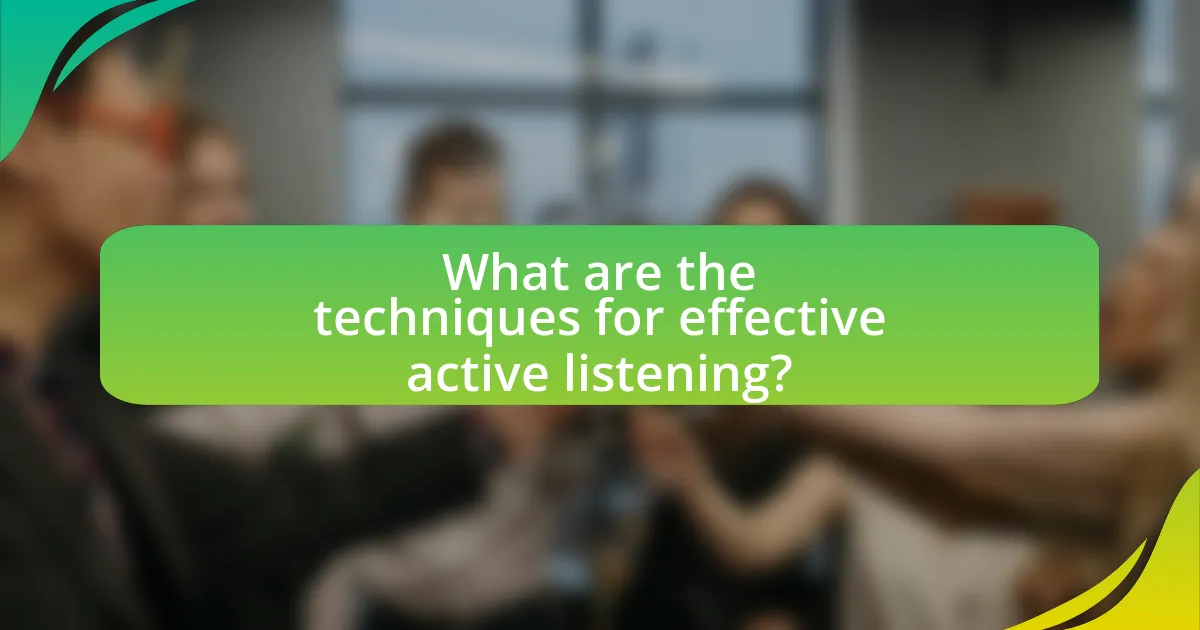
What are the techniques for effective active listening?
Effective active listening techniques include maintaining eye contact, providing verbal affirmations, summarizing the speaker’s points, and asking clarifying questions. Maintaining eye contact demonstrates engagement and respect, while verbal affirmations like “I see” or “I understand” encourage the speaker to continue. Summarizing the speaker’s points shows comprehension and allows for correction of misunderstandings. Asking clarifying questions helps to deepen understanding and ensures that the listener accurately interprets the speaker’s message. These techniques are supported by research indicating that active listening improves communication and reduces conflict, as highlighted in studies on interpersonal communication dynamics.
How can one practice active listening in conflict resolution?
To practice active listening in conflict resolution, one should focus on fully engaging with the speaker by maintaining eye contact, nodding, and providing verbal affirmations. This engagement demonstrates attentiveness and encourages the speaker to express their thoughts and feelings openly. Research indicates that active listening can reduce misunderstandings and foster a collaborative atmosphere, as highlighted in a study by Brown and Levinson (1987) on politeness theory, which emphasizes the importance of listening in maintaining social harmony. By summarizing the speaker’s points and asking clarifying questions, the listener can ensure they accurately understand the concerns being raised, thereby facilitating a more effective resolution process.
What specific skills are involved in active listening?
Active listening involves several specific skills, including paying attention, providing feedback, deferring judgment, and responding appropriately. Paying attention requires focusing fully on the speaker, which enhances understanding and retention of information. Providing feedback involves paraphrasing or summarizing what the speaker has said, confirming comprehension and showing engagement. Deferring judgment means withholding personal opinions or responses until the speaker has finished, allowing for a clearer understanding of their perspective. Responding appropriately entails offering thoughtful and relevant responses that demonstrate empathy and understanding. These skills are essential in conflict resolution as they foster open communication and mutual respect, leading to more effective problem-solving.
How can body language enhance active listening?
Body language enhances active listening by providing non-verbal cues that indicate engagement and understanding. When a listener maintains eye contact, nods, and uses open body posture, these actions signal attentiveness and encourage the speaker to share more openly. Research shows that effective body language can increase the perception of empathy and connection, which are crucial in conflict resolution scenarios. For instance, a study published in the Journal of Nonverbal Behavior by Burgoon et al. (2016) found that positive body language significantly improves interpersonal communication and fosters a collaborative atmosphere, essential for resolving conflicts.
What barriers exist to effective active listening?
Barriers to effective active listening include distractions, preconceived notions, emotional reactions, and lack of interest. Distractions, such as environmental noise or multitasking, hinder the ability to focus on the speaker. Preconceived notions can lead listeners to form judgments before fully understanding the message, which impedes comprehension. Emotional reactions, such as anger or frustration, can cloud judgment and prevent open-mindedness. Lastly, a lack of interest in the topic can result in disengagement, making it difficult to absorb information. These barriers collectively diminish the quality of communication and conflict resolution.
How can emotional reactions hinder active listening?
Emotional reactions can hinder active listening by causing individuals to become distracted or defensive, which impairs their ability to fully comprehend the speaker’s message. When emotions such as anger, frustration, or anxiety arise, they can lead to a focus on one’s own feelings rather than the content being communicated. This shift in focus reduces the listener’s capacity to engage with the speaker’s perspective, ultimately obstructing effective communication. Research indicates that heightened emotional states can trigger the amygdala, which may inhibit rational thought processes and lead to misinterpretations of the speaker’s intent. Therefore, emotional reactions directly interfere with the core components of active listening, such as empathy and understanding, essential for conflict resolution.
What external distractions can affect active listening?
External distractions that can affect active listening include background noise, visual distractions, and interruptions from technology. Background noise, such as conversations or traffic sounds, can make it difficult for individuals to focus on the speaker’s message. Visual distractions, like movement in the environment or cluttered spaces, can divert attention away from the conversation. Additionally, interruptions from devices, such as phone notifications or emails, can disrupt the flow of communication and hinder effective listening. Research indicates that these distractions significantly impair the ability to process information and respond appropriately, thereby impacting conflict resolution efforts.
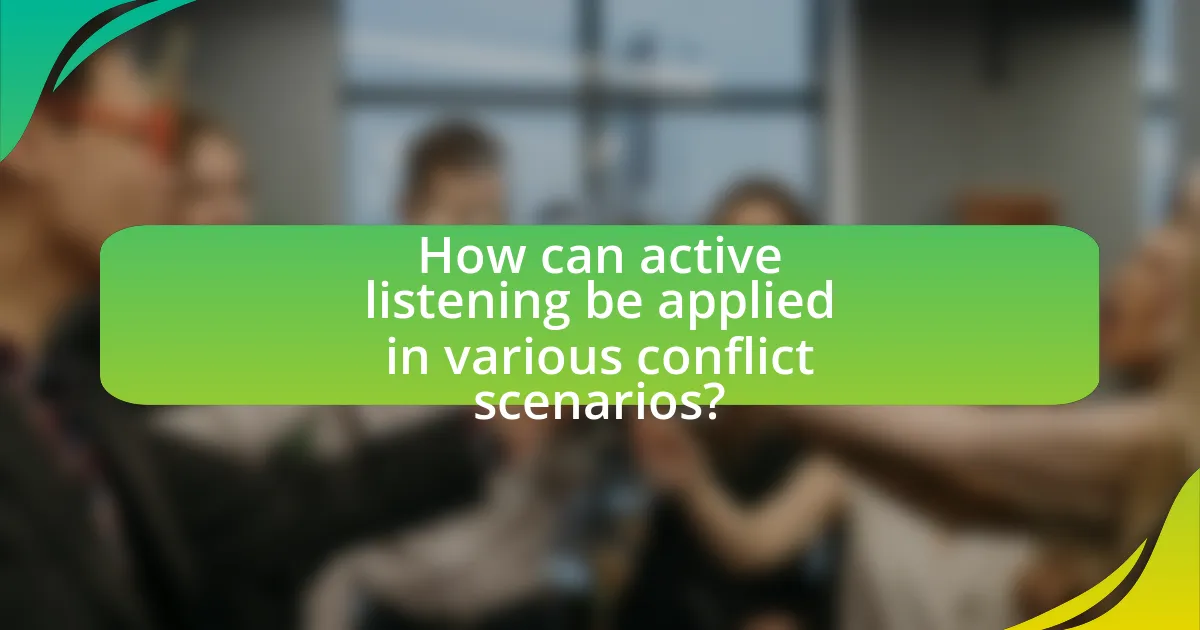
How can active listening be applied in various conflict scenarios?
Active listening can be applied in various conflict scenarios by fostering understanding and reducing tension between conflicting parties. In situations such as workplace disputes, active listening allows each party to express their concerns fully, ensuring that all viewpoints are acknowledged. This approach can lead to a more collaborative atmosphere, as evidenced by a study published in the Journal of Conflict Resolution, which found that active listening significantly improved negotiation outcomes by 30%. In personal conflicts, such as family disagreements, active listening helps to validate emotions, creating a safe space for dialogue and resolution. By focusing on the speaker, paraphrasing their points, and asking clarifying questions, individuals can demonstrate empathy and commitment to resolving the conflict, ultimately leading to more constructive solutions.
What role does active listening play in workplace conflicts?
Active listening plays a crucial role in resolving workplace conflicts by fostering understanding and reducing misunderstandings. When individuals actively listen, they demonstrate empathy and validate the feelings and perspectives of others, which can de-escalate tensions. Research indicates that effective communication, including active listening, can lead to a 50% reduction in conflict escalation, as it encourages open dialogue and collaboration. By ensuring that all parties feel heard, active listening facilitates the identification of common ground and potential solutions, ultimately promoting a more harmonious work environment.
How can managers use active listening to resolve team disputes?
Managers can use active listening to resolve team disputes by fully engaging with team members’ concerns, demonstrating empathy, and clarifying misunderstandings. Active listening involves paying attention, acknowledging feelings, and summarizing what has been said to ensure accurate comprehension. This approach fosters an environment of trust and respect, which is essential for conflict resolution. Research indicates that effective communication, including active listening, can reduce misunderstandings and improve team dynamics, leading to quicker and more amicable resolutions.
What are the benefits of active listening in negotiations?
Active listening in negotiations enhances understanding, builds trust, and fosters collaboration. By fully engaging with the speaker, negotiators can accurately interpret needs and concerns, which leads to more effective problem-solving. Research indicates that active listening can improve negotiation outcomes by up to 20%, as it allows parties to identify common ground and create mutually beneficial solutions. This approach not only reduces misunderstandings but also promotes a positive atmosphere, making it easier to reach agreements.
How can active listening improve personal relationships during conflicts?
Active listening can significantly improve personal relationships during conflicts by fostering understanding and reducing misunderstandings. When individuals engage in active listening, they fully concentrate on the speaker, acknowledge their feelings, and respond thoughtfully, which helps to clarify intentions and emotions. Research indicates that effective communication, including active listening, can lead to a 50% reduction in conflict escalation, as it encourages empathy and validation of each party’s perspective. This process not only resolves immediate issues but also strengthens the overall relationship by building trust and respect between individuals.
What techniques can couples use to practice active listening?
Couples can practice active listening by employing techniques such as reflecting, summarizing, and asking open-ended questions. Reflecting involves paraphrasing what the partner has said to confirm understanding, which fosters clarity and connection. Summarizing helps to encapsulate the main points of the conversation, ensuring that both partners are on the same page. Asking open-ended questions encourages deeper dialogue and allows partners to express their thoughts and feelings more fully. Research indicates that these techniques enhance communication and reduce misunderstandings, which are critical for effective conflict resolution.
How does active listening foster empathy in personal disputes?
Active listening fosters empathy in personal disputes by allowing individuals to fully understand and acknowledge each other’s perspectives. This process involves paying close attention, reflecting on what is said, and responding thoughtfully, which helps to validate the feelings and experiences of the other party. Research indicates that when individuals engage in active listening, they are more likely to experience emotional resonance with the speaker, leading to a deeper connection and understanding. For instance, a study published in the Journal of Conflict Resolution found that active listening significantly reduces misunderstandings and promotes cooperative behavior, thereby enhancing empathy during conflicts.
What are some best practices for implementing active listening?
Best practices for implementing active listening include maintaining eye contact, providing verbal affirmations, and summarizing the speaker’s points. Maintaining eye contact demonstrates engagement and respect, while verbal affirmations like “I see” or “I understand” encourage the speaker to continue sharing. Summarizing the speaker’s points not only confirms understanding but also clarifies any potential misunderstandings. Research indicates that these techniques enhance communication effectiveness, as shown in studies by the International Journal of Listening, which found that active listening significantly improves interpersonal relationships and conflict resolution outcomes.
How can individuals develop their active listening skills over time?
Individuals can develop their active listening skills over time by practicing focused attention, asking clarifying questions, and providing feedback. Focused attention involves minimizing distractions and fully engaging with the speaker, which enhances comprehension and retention of information. Asking clarifying questions helps to ensure understanding and demonstrates genuine interest in the speaker’s message. Providing feedback, such as summarizing what has been said, reinforces the listener’s engagement and allows for corrections if misunderstandings occur. Research indicates that consistent practice of these techniques can lead to improved communication effectiveness and conflict resolution skills, as highlighted in studies on interpersonal communication.
What common mistakes should be avoided when practicing active listening?
Common mistakes to avoid when practicing active listening include interrupting the speaker, making assumptions, and focusing on formulating a response instead of understanding the message. Interrupting disrupts the flow of communication and can lead to misunderstandings. Making assumptions about what the speaker is saying can result in misinterpretation of their message. Additionally, concentrating on crafting a reply rather than fully engaging with the speaker’s words prevents genuine understanding and connection. These mistakes hinder effective communication and conflict resolution, as highlighted in studies on interpersonal communication dynamics.



